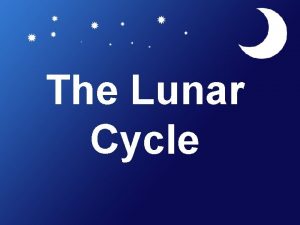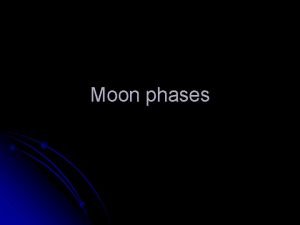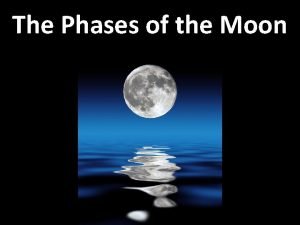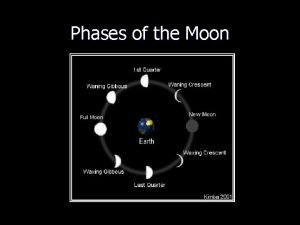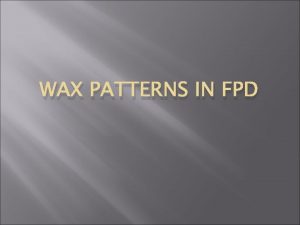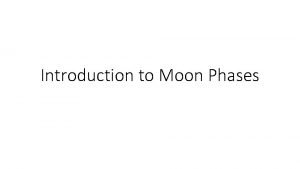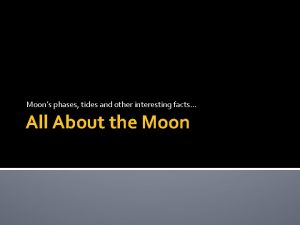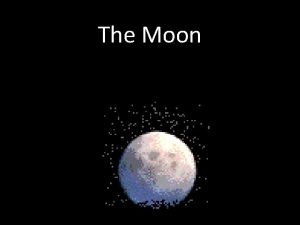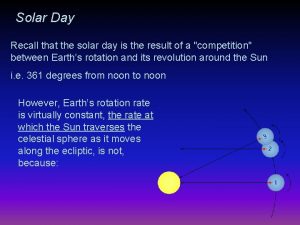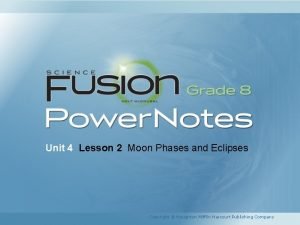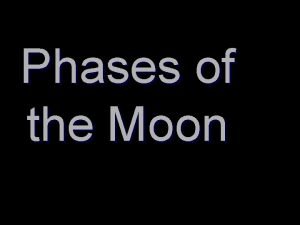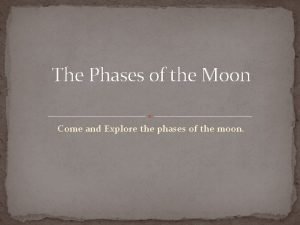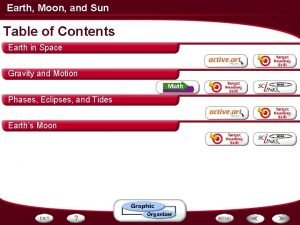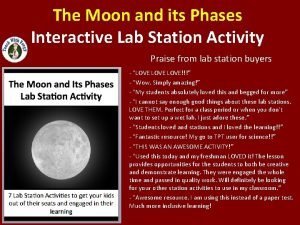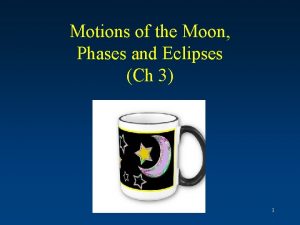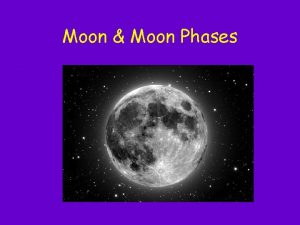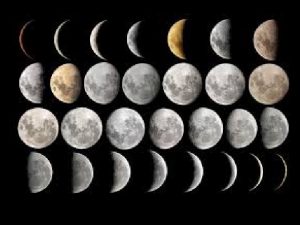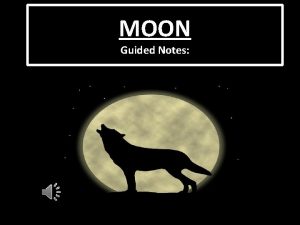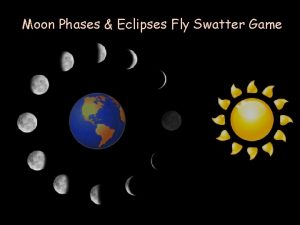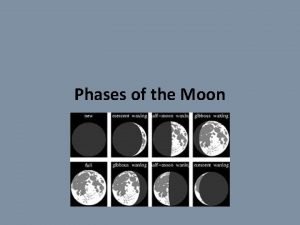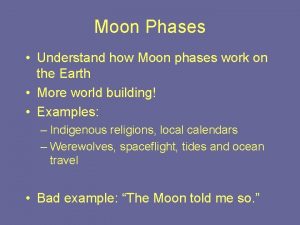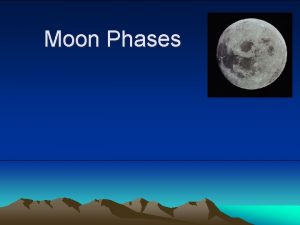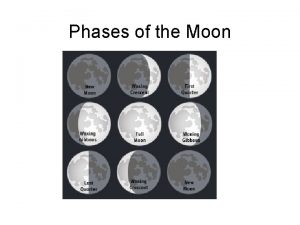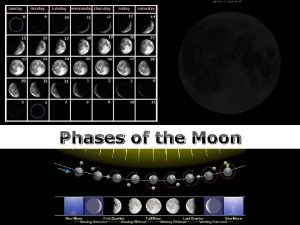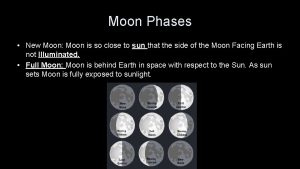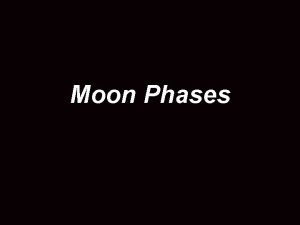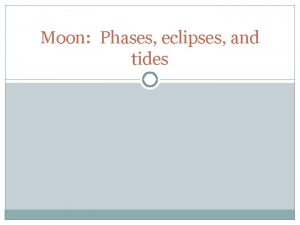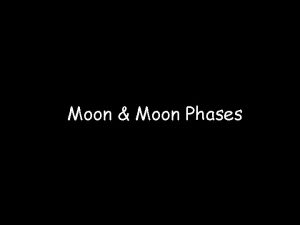Moon phases Moon Phases Terms Waxing moon getting























- Slides: 23

Moon phases

Moon Phases Terms Waxing – moon getting bigger l Waning – moon getting smaller l Crescent – moon less than half full l Gibbous – moon more than half full l

What causes phases of the moon? The orbit of the Moon around the Earth. l We can only see part of the illuminated portion l

What do we see? Half of the Moon is always illuminated l Half of the moon always faces Earth l Where the halves overlap, we see phases l

What do we see? It takes 28 days for the moon to make a complete orbit l This means the cycle repeats about once a month l

Waxing and Waning Waxing - Moving towards a full moon l Waning – Moving towards a new moon l

New Moon New moon l l When the near side is totally in shadow Rises at sunrise Overhead at noon Sets at sunset

Waxing moons Waxing crescent l l Between new and first quarter Rises after sunrise Overhead in the afternoon Sets after sunset

Waxing moons l l l First quarter Between new and full We see half of the illuminated half Half of half = ¼ Rises at noon Overhead at sunset Sets at midnight

Waxing moons Waxing Gibbous l l More than quarter but less than full Rises after noon Overhead in evening Sets after midnight

l l When the near side is totally illuminated Rises at sunset Overhead at midnight Sets at sunrise Full Moon

Waning moons Waning Gibbous l l Less than full, more than third quarter Rises after sunset Overhead after midnight Sets after sunrise

Waning moons Third quarter l l l Between full and new We see half of the illuminated half Half of half = ¼ Rises at midnight Overhead in early morning Sets at noon

Waning moons Waning Crescent l l Between third quarter and new Rises at just before sunrise Overhead just before noon Sets just before sunset

Formation of the Moon Where did it come from?

Points to keep in mind l Any theory of lunar formation must account for: l The moon is as old as Earth, l is made of the same rock as Earth l Has no water l Is getting further away from Earth l Has little iron

Did the moon. . Spin off from Earth? l Form somewhere else? l Form alongside Earth? l Form from an impact? l

Fission Theory Moon spun off from a rapidly spinning molten Earth l Problem – Earth’s gravity should have pulled the bulge back in l

Capture Theory Moon formed somewhere else and was captured by Earth’s gravity l Problem – something would have to slow down the moon l Doesn’t explain lack of water, or moon moving away l

Coformation Theory Moon and Earth formed side by side from same accretion disk. l Problem – lack of iron, lack of water, moon moving away l Earth would have cleared its orbit l

Giant Impact theory Mars sized planetoid impacted Earth. l Moon formed from debris cloud. l Most accepted theory l

Giant Impact Theory

How do they stack up Theory Fission Capture Coformation Impact Age Composition No water Moving away No iron
 Whats the lunar cycle
Whats the lunar cycle Phases of the.moon
Phases of the.moon The secret to getting ahead is getting started
The secret to getting ahead is getting started During ____ phases more of the moon is visible each night
During ____ phases more of the moon is visible each night Waxing procedure step by step milady
Waxing procedure step by step milady Moon catchin net
Moon catchin net Lost wax technique dentistry
Lost wax technique dentistry Describe what the term waxing means
Describe what the term waxing means What does waxing crescent look like
What does waxing crescent look like Like terms and unlike terms in polynomials
Like terms and unlike terms in polynomials Finding like terms
Finding like terms Crescent moon symbolism
Crescent moon symbolism Phases of moon
Phases of moon Moon phases
Moon phases How does moon phases happen
How does moon phases happen Lesson 2 moon phases and eclipses answer key
Lesson 2 moon phases and eclipses answer key How is the moon illuminated
How is the moon illuminated Seven phases of the moon
Seven phases of the moon Moon phases gif
Moon phases gif The phases of moon occur mainly due to
The phases of moon occur mainly due to Phases of the moon animation
Phases of the moon animation Moon phases characteristics
Moon phases characteristics Moon phases interactive notebook
Moon phases interactive notebook Lunar eclipse moon phase
Lunar eclipse moon phase
